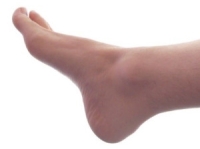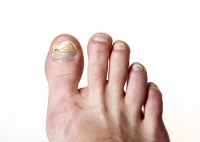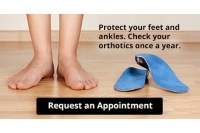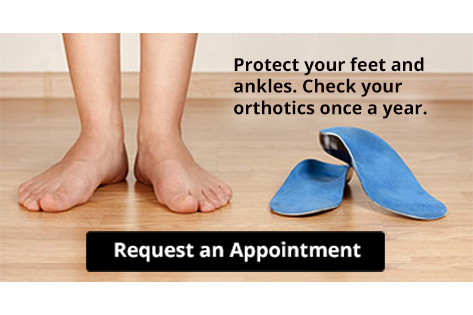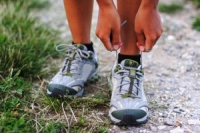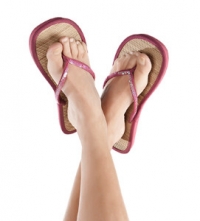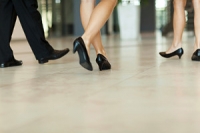
Blog (807)
Are You Suffering from Tarsal Tunnel Syndrome?
Tarsal tunnel syndrome, similar to carpal tunnel in the wrist, is caused by pressure on the tibial nerve in the tarsal tunnel. The tarsal tunnel, located in the ankle and the foot, contains tendons and the tibial nerve. This can create burning, aching, and other painful sensations. Causes of tarsal tunnel syndrome include athletic activity, exercise, and sometimes even flat feet. Tarsal tunnel syndrome can be diagnosed by a podiatrist, who can offer a number of treatments to relieve your pain. It is best to seek out a podiatrist soon, for the longer the nerve is under pressure, the more likely it will take longer and be harder to heal.
Tarsal tunnel syndrome can be very uncomfortable to live with. If you are experiencing tarsal tunnel syndrome, contact Dr. Kenneth Donovan of Advanced Care Foot and Ankle. Our doctor can provide the care you need to keep you pain-free and on your feet.
Tarsal Tunnel Syndrome
Tarsal tunnel syndrome, which can also be called tibial nerve dysfunction, is an uncommon condition of misfiring peripheral nerves in the foot. The tibial nerve is the peripheral nerve in the leg responsible for sensation and movement of the foot and calf muscles. In tarsal tunnel syndrome, the tibial nerve is damaged, causing problems with movement and feeling in the foot of the affected leg.
Common Cause of Tarsal Tunnel Syndrome
- Involves pressure or an injury, direct pressure on the tibial nerve for an extended period of time, sometimes caused by other body structures close by or near the knee.
- Diseases that damage nerves, including diabetes, may cause tarsal tunnel syndrome.
- At times, tarsal tunnel syndrome can appear without an obvious cause in some cases.
The Effects of Tarsal Tunnel Syndrome
- Different sensations, an afflicted person may experience pain, tingling, burning or other unusual sensations in the foot of the affected leg.
- The foot muscles, toes and ankle become weaker, and curling your toes or flexing your foot can become difficult.
- If condition worsens, infections and ulcers may develop on the foot that is experiencing the syndrome.
A physical exam of the leg can help identify the presence of tarsal tunnel syndrome. Medical tests, such as a nerve biopsy, are also used to diagnose the condition. Patients may receive physical therapy and prescriptive medication. In extreme cases, some may require surgery.
If you have any questions please feel free to contact one of our offices located in Warren, Livingston, and Toms River, NJ. We offer the newest diagnostic and treatment technologies for all your foot and ankle needs.
Are You Suffering from Tarsal Tunnel Syndrome?
 Tarsal tunnel syndrome, similar to carpal tunnel in the wrist, is caused by pressure on the tibial nerve in the tarsal tunnel. The tarsal tunnel, located in the ankle and the foot, contains tendons and the tibial nerve. This can create burning, aching, and other painful sensations. Causes of tarsal tunnel syndrome include athletic activity, exercise, and sometimes even flat feet. Tarsal tunnel syndrome can be diagnosed by a podiatrist, who can offer a number of treatments to relieve your pain. It is best to seek out a podiatrist soon, for the longer the nerve is under pressure, the more likely it will take longer and be harder to heal.
Tarsal tunnel syndrome, similar to carpal tunnel in the wrist, is caused by pressure on the tibial nerve in the tarsal tunnel. The tarsal tunnel, located in the ankle and the foot, contains tendons and the tibial nerve. This can create burning, aching, and other painful sensations. Causes of tarsal tunnel syndrome include athletic activity, exercise, and sometimes even flat feet. Tarsal tunnel syndrome can be diagnosed by a podiatrist, who can offer a number of treatments to relieve your pain. It is best to seek out a podiatrist soon, for the longer the nerve is under pressure, the more likely it will take longer and be harder to heal.
Tarsal tunnel syndrome can be very uncomfortable to live with. If you are experiencing tarsal tunnel syndrome, contact Dr. Kenneth Donovan of Advanced Care Foot and Ankle. Our doctor can provide the care you need to keep you pain-free and on your feet.
Tarsal Tunnel Syndrome
Tarsal tunnel syndrome, which can also be called tibial nerve dysfunction, is an uncommon condition of misfiring peripheral nerves in the foot. The tibial nerve is the peripheral nerve in the leg responsible for sensation and movement of the foot and calf muscles. In tarsal tunnel syndrome, the tibial nerve is damaged, causing problems with movement and feeling in the foot of the affected leg.
Common Cause of Tarsal Tunnel Syndrome
- Involves pressure or an injury, direct pressure on the tibial nerve for an extended period of time, sometimes caused by other body structures close by or near the knee.
- Diseases that damage nerves, including diabetes, may cause tarsal tunnel syndrome.
- At times, tarsal tunnel syndrome can appear without an obvious cause in some cases.
The Effects of Tarsal Tunnel Syndrome
- Different sensations, an afflicted person may experience pain, tingling, burning or other unusual sensations in the foot of the affected leg.
- The foot muscles, toes and ankle become weaker, and curling your toes or flexing your foot can become difficult.
- If condition worsens, infections and ulcers may develop on the foot that is experiencing the syndrome.
A physical exam of the leg can help identify the presence of tarsal tunnel syndrome. Medical tests, such as a nerve biopsy, are also used to diagnose the condition. Patients may receive physical therapy and prescriptive medication. In extreme cases, some may require surgery.
If you have any questions please feel free to contact one of our offices located in Warren, Livingston, and Toms River, NJ . We offer the newest diagnostic and treatment technologies for all your foot and ankle needs.
Signs That You May Have Toenail Fungus
People who have toenail fungus often try to conceal the fact by covering it with nail polish, or by using at-home remedies. However, it is always best to consult with a podiatrist prior to doing either of these. According to Shari Lipner, “Nail fungus is the most common nail disorder …. not every nail problem is caused by fungus, and there are several other conditions that may look similar, including nail psoriasis and nail trauma.” It is crucial that you make sure what you have is what you think it is, so that you are not looking for solutions to a problem you do not have. If you have nail trauma and are treating it as if you have a toenail fungus, it is possible that you could worsen your condition.
For more information about treatment, contact Dr. Kenneth Donovan of Advanced Care Foot and Ankle. Our doctor can provide the care you need to keep you pain-free and on your feet.
Toenail Fungus Treatment
Toenail fungus is a condition that affects many people and can be especially hard to get rid of. Fortunately, there are several methods to go about treating and avoiding it.
Antifungals & Deterrence
Oral antifungal medicine has been shown to be effective in many cases. It is important to consult with a podiatrist to determine the proper regiment for you, or potentially explore other options.
Applying foot powder on the feet and shoes helps keep the feet free of moisture and sweat.
Sandals or open toed shoes – Wearing these will allow air movement and help keep feet dry. They also expose your feet to light, which fungus cannot tolerate. Socks with moisture wicking material also help as well.
If you have any questions please feel free to contact one of our offices located in Warren, Livingston, and Toms River, NJ. We offer the newest diagnostic tools and technology to treat your foot and ankle needs.
Reminder: When Was the Last Time…?
Reminder: When Was the Last Time...?
How Proper Footwear Can Protect You Against Injury
You should always make sure you are wearing proper footwear for whichever activity you are about to engage in. Hiker Marci Hansen recalls her experience going hiking with a friend: “I would step on a wet root and it was not even a thing, and she would really slip and fall.” She explains that the difference between her friend and herself is that she came prepared with the right shoes required to go hiking. The cause of her friend’s injuries was the fact that she wore shoes that were not made to endure the wet and uneven surfaces. If you are planning on going hiking, tread is one of the most important things you should look for when shoe shopping. Shoes that are sturdy enough to go hiking will help protect you from injuries that can easily be avoided.
Exercising your feet regularly with the proper foot wear is a great way to prevent injuries. If you have any concerns about your feet, contact Dr. Kenneth Donovan of Advanced Care Foot and Ankle. Our doctor will treat your foot and ankle needs.
How to Prevent Running Injuries
Many common running injuries are caused by overuse and overtraining. When the back of the kneecap starts wearing out and starts causing pain in your knee, this is commonly referred to as runner’s knee. Runner’s knee is a decrease in strength in your quadriceps and can occur if you’re not wearing properly fitted or supporting shoes. To prevent runner’s knee, focusing on hip strengthening is a good idea, as well as strengthening your quads to keep the kneecaps aligned.
What Are Some Causes of Running Injuries?
– One cause of a common running injury is called iliotibial band syndrome.
– Plantar fasciitis is also another common injury.
– Stress fractures can occur from overtraining, lack of calcium, or even your running style.
Best Ways to Prevent Running Injuries
– Wear footwear that fits properly and suits your running needs.
– Running shoes are the only protective gear that runners have to safeguard them from injury.
– Make a training schedule. Adding strengthening exercises as well as regular stretching can help keep you strong and limber and can lessen the possibility of injuries.
– Stretching keeps muscles limber; this will help you gain better flexibility.
If you have any questions please feel free to contact one of our offices located in Warren, Livingston, and Toms River, NJ. We offer the newest diagnostic and treatment technologies for all your foot and ankle needs.
Why You Should Avoid Wearing Flip-Flops
Flip-flops are a common footwear selection for many Americans during the summer. However, these shoes can be very problematic for your feet. While flip-flops may be a better choice compared to walking barefoot, they provide no arch or heel support for your feet. As a result, you may suffer from issues such as plantar fasciitis and stress fractures. If you still choose to wear these shoes despite the dangers they put your feet at risk for, you should choose a pair that are made out of soft leather. If you have an old pair of flip-flops in your closet, you should inspect them and see if they are still fit to wear.
Flip-flops are not always the best choice of footwear. If you have any concerns about your feet or ankles, contact Dr. Kenneth Donovan from Advanced Care Foot and Ankle. Our doctor will assist you with all of your foot and ankle needs.
Flip-Flops and Feet
When the weather starts warming up, people enjoy wearing flip-flops.
Flip-flops are comfortable, stylish, and easy to slip on and off; they're perfect for any summer beach goer.
However, these shoes can cause harm to the feet.
How Can Flip-Flops Affect Me Long-Term?
- Ankle problems
- Hip problems
- Lower back problems
- Pain in the balls of the feet
- Problems with foot arches
- Changes in the way you walk
Are There Injuries Associated with Flip-Flops?
Yes.
Since flip-flops are relatively weak and do not provide the same amount of support as sneakers, people who wear flip-flops regularly are more susceptible to injuries. On top of that, the open nature of the shoe makes your feet more prone to other problems, such as cuts and even infections.
Common injuries and ailments include:
- Sprained ankles
- Blisters
- Infections
- Cuts and Scrapes
I like Wearing Flip-Flops. Are There Safe Alternatives?
When buying flip-flops, try to find ones that have sturdy soles and that are made of high-quality materials that will support for your feet.
These flip-flops will cost more but will also last longer as a result.
If you have any questions please feel free to contact one of our offices located in Warren, Livingston, and Toms River, NJ.
We offer the newest diagnostic and treatment technologies for all your foot and ankle needs.
The Harmful Effects of Working on Your Feet
Many people are required to stand on their feet for long hours in order to do their jobs. As a result, people who work as sales associates, factory workers, and nurses often suffer from a condition called plantar fasciitis which can cause a lot of pain in the heels. People who have plantar fasciitis often complain that their feet hurt within the first few steps of the morning, with the pain slowly disappearing the more they walk around. However, if the condition goes untreated, it may start to worsen. It is important that people with plantar fasciitis seek the help of a podiatrist in order to address their situation and receive treatment.
While working on the feet, it is important to take the proper care of them. For more information about working on your feet, contact Dr. Kenneth Donovan from Advanced Care Foot and Ankle. Our doctor will treat your foot and ankle needs.
Working on Your Feet
Standing on your feet for long periods of time can cause stress and pain in your feet. Your whole body may experience change in terms of posture, back pain, bunions, callouses and or plantar warts. There are ways to avoid these conditions with proper foot care, smart choices and correct posture.
Positive Changes
Negative heeled shoe – Choosing this shoe type places the heel slightly lower than the ball of the foot. These are great for overall foot health. Find shoes that fit you correctly.
Go barefoot – Our feet were not designed to be enclosed for all hours of the day. Try to periodically expose your feet to air.
Eliminate Pain
Foot Exercises – Performing simple exercises, incorporating yoga and doing stretches are beneficial. This will allow increased blood flow to the area and muscles of the foot.
Achilles tendon – Stretching the foot out flat on the floor will relax the calf muscles and tendon. These exercises can be performed almost anywhere. Make sure you add these exercises to your daily regimen.
With a little bit of this information and knowing more about foot health, you will notice changes. Foot stretches and proper footwear will help with pain and prevent further issues.
If you have any questions please feel free to contact one of our offices located in Warren, Livingston, and Toms River, NJ. We offer the newest diagnostic and treatment technologies for all your foot and ankle needs.
The Harmful Effects of Working on Your Feet
 Many people are required to stand on their feet for long hours in order to do their jobs. As a result, people who work as sales associates, factory workers, and nurses often suffer from a condition called plantar fasciitis which can cause a lot of pain in the heels. People who have plantar fasciitis often complain that their feet hurt within the first few steps of the morning, with the pain slowly disappearing the more they walk around. However, if the condition goes untreated, it may start to worsen. It is important that people with plantar fasciitis seek the help of a podiatrist in order to address their situation and receive treatment.
Many people are required to stand on their feet for long hours in order to do their jobs. As a result, people who work as sales associates, factory workers, and nurses often suffer from a condition called plantar fasciitis which can cause a lot of pain in the heels. People who have plantar fasciitis often complain that their feet hurt within the first few steps of the morning, with the pain slowly disappearing the more they walk around. However, if the condition goes untreated, it may start to worsen. It is important that people with plantar fasciitis seek the help of a podiatrist in order to address their situation and receive treatment.
While working on the feet, it is important to take the proper care of them. For more information about working on your feet, contact Dr. Kenneth Donovan from Advanced Care Foot and Ankle. Our doctor will treat your foot and ankle needs.
Working on Your Feet
Standing on your feet for long periods of time can cause stress and pain in your feet. Your whole body may experience change in terms of posture, back pain, bunions, callouses and or plantar warts. There are ways to avoid these conditions with proper foot care, smart choices and correct posture.
Positive Changes
Negative heeled shoe – Choosing this shoe type places the heel slightly lower than the ball of the foot. These are great for overall foot health. Find shoes that fit you correctly.
Go barefoot – Our feet were not designed to be enclosed for all hours of the day. Try to periodically expose your feet to air.
Eliminate Pain
Foot Exercises – Performing simple exercises, incorporating yoga and doing stretches are beneficial. This will allow increased blood flow to the area and muscles of the foot.
Achilles tendon – Stretching the foot out flat on the floor will relax the calf muscles and tendon. These exercises can be performed almost anywhere. Make sure you add these exercises to your daily regimen.
With a little bit of this information and knowing more about foot health, you will notice changes. Foot stretches and proper footwear will help with pain and prevent further issues.
If you have any questions please feel free to contact one of our offices located in Warren, Livingston, and Toms River, NJ . We offer the newest diagnostic and treatment technologies for all your foot and ankle needs.
The Importance of Foot Care
There are many different types of conditions that you may experience in your feet, and they become more noticeable during the summer when you show them off the most. A notoriously famous issue that people experience is toenail fungus. Toenail fungus has the power to make your beautiful toenails become discolored, thick, and brittle. One of the earliest signs of toenail fungus is a white speck near the edge of a nail that spreads to your other nails. Another problematic foot condition may be the development of corns. Corns and calluses are often the result of an excess amount of friction on the feet. They often form on the outside of the small toe and appear as thickened mounds of skin. If you are dealing with toenail fungus or painful corns, you should make an appointment with your podiatrist in order to treat your condition.
Everyday foot care is very important to prevent infection and other foot ailments. If you need your feet checked, contact Dr. Kenneth Donovan from Advanced Care Foot and Ankle. Our doctor can provide the care you need to keep you pain-free and on your feet.
Everyday Foot Care
Often, people take care of their bodies, face and hair more so than they do for their feet. But the feet are a very important aspect of our bodies, and one that we should pay more attention to. Without our feet, we would not be able to perform most daily tasks.
It is best to check your feet regularly to make sure there are no new bruises or cuts that you may not have noticed before. For dry feet, moisturizer can easily be a remedy and can be applied as often as necessary to the affected areas. Wearing shoes that fit well can also help you maintain good foot health, as well as making it easier to walk and do daily activities without the stress or pain of ill-fitting shoes, high heels, or even flip flops. Wearing clean socks with closed shoes is important to ensure that sweat and bacteria do not accumulate within the shoe. Clean socks help to prevent Athlete’s foot, fungi problems, bad odors, and can absorb sweat.
If you have any questions please feel free to contact one of our offices located in Warren, Livingston, and Toms River, NJ. We offer the newest diagnostic and treatment technologies for all your foot and ankle needs.

